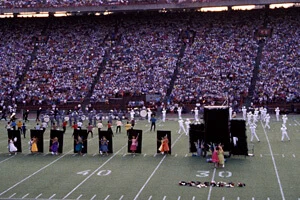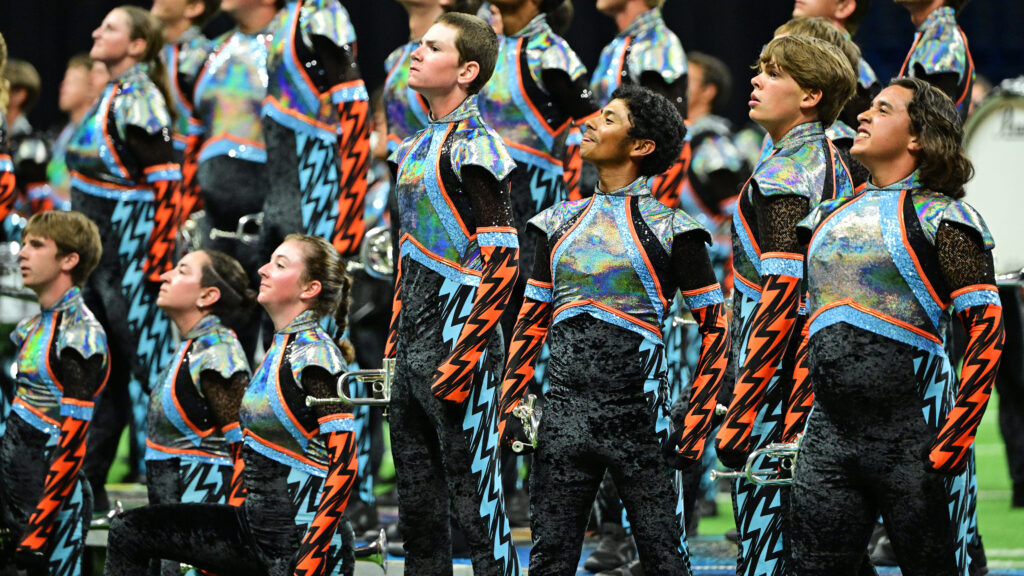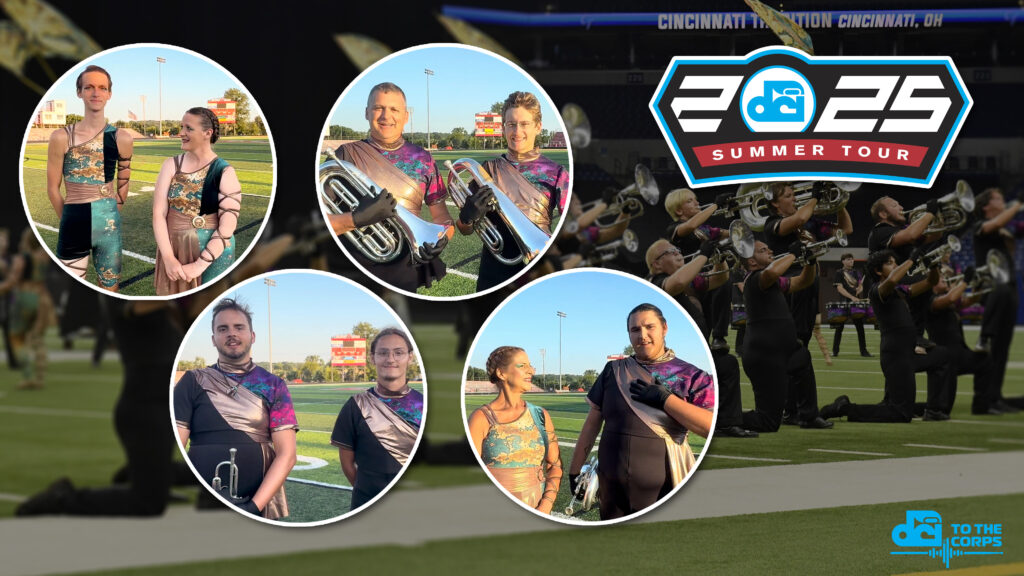
1987 Sky Ryders
Over the years a lot of corps have played music from “West Side Story,” but for many fans, Sky Ryders’ 1987 12th place show remains one of the most memorable “WSS” shows ever. It’s also quite possibly the most memorable show to ever place in 12th at the DCI World Championships.
The most literal interpretation of the musical ever to hit the field resonated deeply with audiences. This was largely due to the decision of visual coordinator Tommy Keenum to not just play Leonard Bernstein’s music of “West Side Story,” but to convey lyricist Stephen Sondheim’s story with all its humor and sorrow intact.
The Sky Ryders divided up into units of different colored uniforms; half the brass section in solid white, (including shakos), the other half in solid black and percussion in gray. The two different colors represented the different gangs of the Sharks and Jets, and until the end of the show, drill writer Marc Sylvester kept them apart from each other. The gray of the percussion uniforms allowed the drums, in essence, to be non-aligned to either side and float between the two “warring” horn sections at will.
A tall set of scaffolding risers at the back of the field was utilized throughout the show with different scene changes creating an appropriate backdrop for whatever the mood was at the moment. At the start of the show, in “Prologue,” a male color guard member leapt off the middle of the risers from about eight feet high, setting the stage for the drama to follow. The male guard members portrayed the two gangs and the female guard members played the parts of their girlfriends, with Maria’s Shark relatives and acquaintances trying to keep her away from Tony and his fellow Jets friends.
The tenderness of “Maria” introduced the females in the guard in different-colored long flowing formal gowns that filled up the field as if extensions of the long flags that were the same colors. Waiting their turn, the males of the guard took over with rifles in the far more energetic “Mambo,” strutting their stuff while wearing their Sunday best.
“Gee, Officer Krupke” brought out uniformed policemen playing the part of the title character, with the other males, still in sports coats, pleading their case in front of large black screens that became judges’ benches. White powdered wigged judges passed judgment on the delinquents for their indiscretions, with large gavels applied directly to the heads of the accused.
The whole piece was played to maximum humor value. When, in the musical, the lyrics state, “Gee, Officer Krupke, We’re down on our knees,” the brass players in white knelt and progressed toward the stands on their knees, backing up the pleading defendants who then went on to catch the rifles of all the Krupkes and bopped the officers on their heads.
Performance excerpt of the 1987 Sky Ryders.
To a mixture of tunes from the musical about the love of Tony and Maria, with stained glass windows appearing across the field, Maria shows up in a white wedding dress and Tony in a tuxedo. The two sections of brass are still kept apart from each other. The interlude is all too brief, and a riot breaks out between the two gangs, with the violence played out against the superimposed melody of “Maria” as the females seem caught up in planning the wedding, unaware their boyfriends are trying to kill each other.
Tony gets shot just as he and Maria unite after they run toward each other, and she tries to comfort him during “Somewhere,” as the male guard members, realizing they’ve gone too far, appear shocked and ashamed and then carry away Tony’s body. Maria contemplates shooting herself, and during all this, the two sides of brass finally come together, zippering the two former adversaries into a continuous waving arc of alternate black and white.
The color guard members, now all attired in various shades of pastels with matching long flag banners, fill the field with a glorious sense of hope arising out of the tragedy. Maria, though she didn’t kill herself, holds up a large white transparent angel’s wing assemblage and looks through the open ring at the top, becoming an angel. At this point, Tony joins her and they both run off the field, the angel’s outfit fluttering behind them. And as they disappeared, each of the brass players turned to their former enemy next to them and embraced in an act of giving forgiveness and asking for it in return.
It’s not explained whether Maria died or somehow Tony lived, or if they met on some metaphysical plane that cannot be explained by mere mortals. We just know they were united forever in their love, and as they exited the field, countless tissues exited from the pockets and purses of those in the stands.
This week only, you can save on 1987 World Championship Audio and Video Performance Downloads on the DCI Fan Network.
Buy the 1987 Sky Ryders Video Performance Download.
(Available this week only for $3.99. Regular price: $4.99.)
Buy the Audio Performance Download bundle of all 12 Finalists from 1987.
(Available this week only for $15.99. Regular price: $19.99.)
Offer ends Monday, Nov. 7 at 8:30 a.m. ET.

Michael Boo was a member of the Cavaliers from 1975-1977. He has written about the drum corps activity for more than a quarter century and serves as a staff writer for various Drum Corps International projects. Boo has written for numerous other publications and has published an honors-winning book on the history of figure skating. As an accomplished composer, Boo holds a bachelor's degree in music education and a master's degree in music theory and composition. He resides in Chesterton, Ind.





